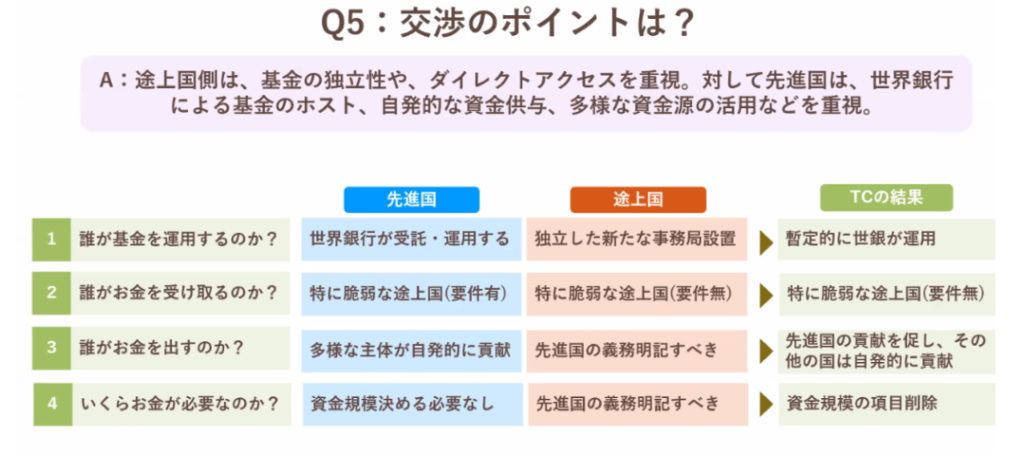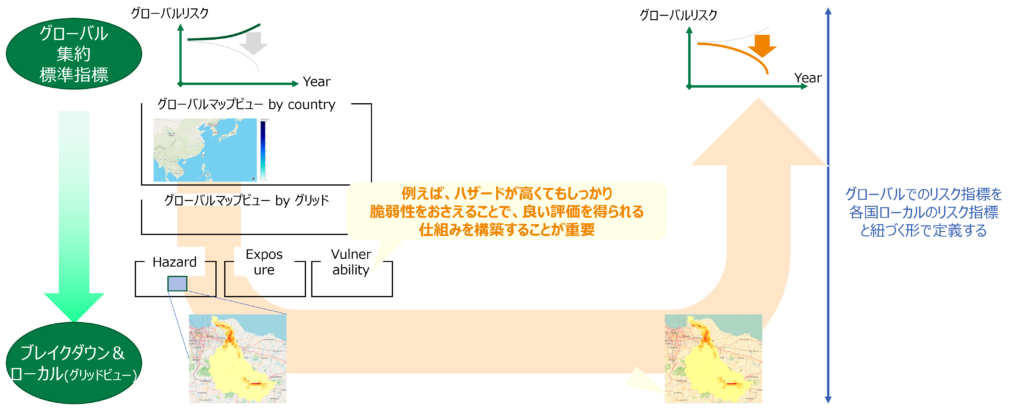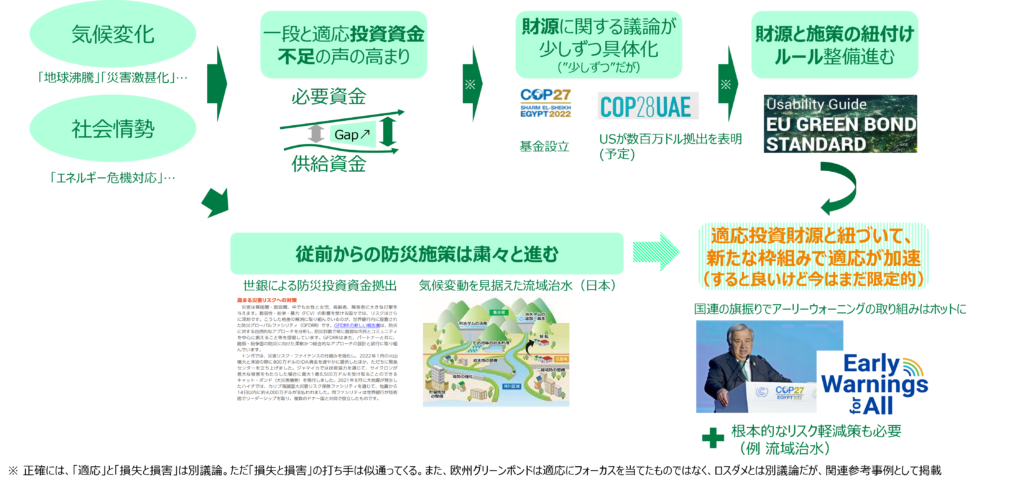Column
2023年11月30日
Review of past discussions at COP and highlights of COP28
COP28 has started today, and there are many interesting topics including the progress check-in on the 1.5°C target.
In this article, I would like to review the discussions at COP27 and around the world, especially in the area of climate change adaptation, and write down my highlights of the discussions at COP28.
1. Past discussions (at COP, related to climate change adaptation): Establishment of the loss & damage fund and rising expectations for financial contributions from developed countries
As is widely known, one of the big outcomes from COP27 was the establishment of the loss & damage fund. (It is understood that loss is what was lost due to climate-related disasters, and damage is the damage suffered if not necessarily lost.) The loss & damage fund is a fund that includes the indication that developed countries will contribute funds to compensate for the damage that developing countries have suffered and to mitigate future damage.
There has long been a conflict between developing and developed countries. Developing countries claim that developed countries who have largely emitted GHG are responsible for climate-related disasters and should compensate developing countries for the damage they have suffered, whereas developed countries want to avoid discussions on the issue of such responsibility.
* It may seem that developed nations should be reasonably responsible, yet I understand that damage caused by disasters is a complex combination of natural and human-induced changes, and it is extremely difficult to determine who should be held responsible for what.
Another argument from developed countries was that support for disaster prevention, response, and recovery for developing countries is already provided within the existing framework of the World Bank and other organizations, and that it would be a good idea to build on to such framework.
The discussions at COP27 were very intensive, but the European side shifted to support the establishment of the Fund towards the end of the meeting, and this is said to have led to the outcome of “the establishment of the fund”.
I understand that there were some compromises also made by developing countries. For example, the target of assistance should be “focused on particularly vulnerable developing countries,” and sources of funds other than contributions by developed countries should be explored.
The problem, however, lies beyond this. The question is “Who will contribute how much amount of funds?”
This will not be an easy question, but it is necessary to gradually finalize the discussion.
In anticipation of COP28, in November 2023, US Special Presidential Envoy for Climate John Kerry announced the provision of millions of dollars in funding, and it is expected that the discussion of funding sources will also progress, albeit gradually. (Although some may criticize that “a few million dollars is not much,” we believe it is important to start from 0 to 1.)
Ref) Kerry’s Promise of ‘Millions’ for Climate Damages Criticized by Activists
IGES’s report further covers this topic well.
Ref) https://www.iges.or.jp/jp/projects/cop28

2. Past discussions (climate change adaptation-related topics including outside of COP): Expansion of the adaptation investment gap, movement to materialize sources of fund
UNEP, a UN-affiliated environmental organization, publishes a report called the Adaptation Gap Report every year.
According to the 2023 report, the Adaptation Gap is currently 10 to 18 times, growing larger than the previous year.
The Adaptation Gap refers to the gap between the global funding needed for climate change adaptation and the actual funding provided.
The required funds are calculated by several methods and are modeled and calculated.
The provided funds likely count, for instance, the World Bank’s contribution to climate change adaptation.

In light of these claims of funding shortfalls, there are some examples where specific funding schemes are proposed.
Barbados is said to be a “sinking island country” due to rising sea levels. Against this backdrop, Prime Minister Motley has been advocating new financial schemes to secure financial resources in advance of the IMF’s annual meeting.
For example, he says that $100 billion of unused SDRs (Special Drawing Rights) should be redistributed to countries in need. SDRs are a type of currency-like international reserve asset issued by the IMF. They were originally established in 1969 as a new reserve asset to supplement the dollar, which was considered insufficient as an international liquidity asset as the gold-dollar standard began to waver. It is convertible into five currencies: the US dollar, Euro, Chinese Yuan, Japanese Yen, and British Pound, but is used for limited occasions such as government debt. It is our understanding that this is a proposed method for developing countries to raise necessary funds in a way that is relatively easy for developed countries to accept among existing schemes.
Source: https://toyokeizai.net/articles/-/625797
Considering the future flow of funds, it will also be necessary to develop a transparent scheme for whether the use of funds is appropriate.
This is not necessarily limited to climate change adaptation, but the EU has been progressing in setting green bond standards, which were adopted this year (2023). The standards are generally consistent with the taxonomy. (The taxonomy itself is a scheme that attempts to draw a line between what is “green” or not, such as “what is clean energy,” and climate change adaptation is included as one of the criteria.)
In Japan, for example, RIEF has published a draft guidance on adaptation finance.
Ref. https://rief-jp.org/ct4/137369
3. Discussion point: On top of funding, the goal of adaptation is important (including Early Warning System and others)
So far, funding has been the main focus, but of course “specific adaptation measures”, or the uses, are very important.
- To be precise, “loss & damage” and “adaptation” are two different discussions (loss & damage has the connotation of “restoration/compensation for damage caused by climate disasters that have already occurred,” whereas adaptation has the connotation of “preparing for future climate disasters”)
- However, the Paris Agreement states that “avoidance, minimization, and response to losses and damages are important” while the examples given are adaptation itself (e.g., establishment of an early warning system, etc.).
- In addition, it is extremely difficult to discuss “responsibility for damage that has occurred in the past” (and therefore which country should pay how much), and I understand that it is better to consider loss prevention and adaptation in a comprehensive manner concerning the use of funds.
One of the adaptation measures that has been stressed recently is the “Early Warning System”. This refers to the early alerting of people when natural disasters are predicted, and taking appropriate pre-emptive measures such as evacuation.
In 2022, UN Secretary-General Guterres proposed that the Early Warning System should be implemented worldwide within five years, and since then the World Meteorological Organization (WMO) and various organizations have been working on this initiative.
- Gaia Vision’s real-time flood forecasting solution is also a key component to advancing the Early Warning System.
- At the Japan Pavilion at COP28, Gaia Vision’s products were featured as one of the Early Warning System-related products in Japan.
In Japan, the EWS Council was established under the leadership of MOE in 2023, and one of its objectives is to respond to global trends and needs through collaboration among domestic players, including Gaia Vision.
On the other hand, the Early Warning System is not (of course) the versatile answer.
The Early Warning System is rather more of a “last solution,” and the important thing is to be well prepared before a disaster strikes. It is about making steady and precise risk assessments that take future climate change into account, and (in the case of floods) implementing appropriate flood control measures (river channel excavation, dam/levee/reservoir construction, etc.) – and continuing to do so.
We believe that the above funding stream will be essentially important in terms of whether it leads to appropriate risk assessment and selection of measures with a holistic view, for both the Early Warning System and other measures.
- Gaia Vision is conducting research and development of flood control effectiveness assessment solutions, some of which will be introduced at COP28.
4. Highlights of COP28: Funding and scheme of loss & damage fund and embodiment of Adaptation Targets
Based on the above, my highlights of COP28 are the following two points.
1. How far would the discussion on the funding/scheme of the loss & damage fund progress?
- Regarding the funding sources, as mentioned above, there is an expectation for a financial contribution statement from the developed countries. How this will turn out is the first thing to watch.
- The interest should not only be on “who will pay how much.”
Japan’s GX strategy aims to leverage JPY 10 trillion in government-led investment to create a flow of funds amounting to JPY 150 trillion. I believe that the highlight of COP27 was that there is space left for implications other than “only developed countries should contribute funds”. While I believe that international conferences usually remain abstract to build consensus, it will be interesting to see if the discussion on funding sources will progress even a little bit. - In addition, it will be interesting to see what new content will be proposed from the previous scheme (e.g., the World Bank’s assistance to developing countries). Some say that developing countries are looking for a new scheme from various perspectives. It has been decided that the World Bank will operate the scheme for the next four years temporarily, but it will be interesting to see if there will be any further discussions.
2. Would there be some language on the goal of adaptation or loss & damage?
- As mentioned above, what is essentially important is how to use the funds and achieve what kind of “adapted world”.
- It is unlikely that specific adaptation measures will be discussed during COP28. Yet, CO 26 has adopted a proposal to make progress in discussions on “adaptation goals”.
- Glasgow – Sharm el-Sheikh (GlaSS) work programme on the global goal on adaptation
- GGA: Global Goal on Adaptation
→ This is due to the fact that in the world of climate change mitigation, clear targets such as “carbon neutrality by 20xx” are typically set, whereas in the world of adaptation, there are difficulties in setting targets (especially in quantification).
- Under such circumstances, it is difficult to imagine that any concrete decision will be made at an international conference like COP, but we still would like to follow if any outputs (like general frameworks) are achieved.
- Gaia Vision also calls for the concept of creating a system that grasps global risks by the accumulation of local risks, as shown in the figure below, so that the effects of investment in adaptation can be seen on a worldwide basis.
- We deal with not only floods but also sea level rise, natural capital, health hazards, and many others. This is also not a topic that will be agreed upon at international conferences as the prominent phenomena differ greatly from country to country. However, I am particularly interested to see if there will be any discussion this year, as heat waves/forest fires/water resources/ biodiversity, in addition to floods, are also attracting attention.

5. Summary
In response to the recent rise in climate change topics, not limited to COP, we consider the following five perspectives to be the most important trends.
- Growing attention to the lack of adaptation finance
- More concrete discussions on funding sources
- Efforts to link funding and measures ーーーーDiscussion on funding schemes up to here
- Rising initiatives of investment in disaster prevention from the past
- International top-down movement to promote new measures ーーーーDiscussion on specific adaptation measures

In particular, as shown in the bottom-right corner of the figure above, we believe it is important to “correctly” link the financial scheme discussions in the upper rows to adaptation measures. It is difficult to define what “correctly” means, but it is desirable to understand the overall picture and priorities of risks, taking future climate change into account, and to work on a comprehensive approach, including Early Warning System and other measures.
Gaia Vision aims to reduce the risk of disasters, which are intensifying due to climate change. Using high-resolution global flood simulation technology, we are working on 1. climate change risk analysis platform, 2. real-time flood forecasting, and 3. flood control effectiveness assessments. In the first case, our ability to analyze future climate scenarios on a global scale at high resolution has been particularly well received, and we have been featured in a guide by MLIT and have created some business cases. In 2., a prototype has been developed to forecast flood inundation at a specific location with a lead time of one day or more and is expected to be used for evacuation orders by local governments and for preventive measures in the manufacturing and infrastructure industries. In 3., we are developing a system to connect to appropriate flood control projects based on simulations of anticipated damage.
We hope that this will be of interest to those in the manufacturing, infrastructure, real estate, logistics, and construction industries who have multiple global locations, to financial institutions that invest in and finance these companies, and to local governments and public organizations involved in river/crisis management. If you have any questions, please feel free to contact us.
News
- 2024年05月10日 Gaia Vision is listed in “Summary of Recommended DX Service and Solution Providers”.
- 2024年05月01日 Gaia Vision is listed in “Summary of Recommended DX Service and Solution Providers”.
- 2024年04月16日 Gaia Vision is listed in “Summary of Recommended DX Service and Solution Providers”.
- 2024年04月14日 Gaia Vision is listed in “Summary of Recommended DX Service and Solution Providers”.
- 2024年03月29日 Gaia Vision is listed in “Summary of Recommended DX Service and Solution Providers”.
Column
-
-
-
-
-

